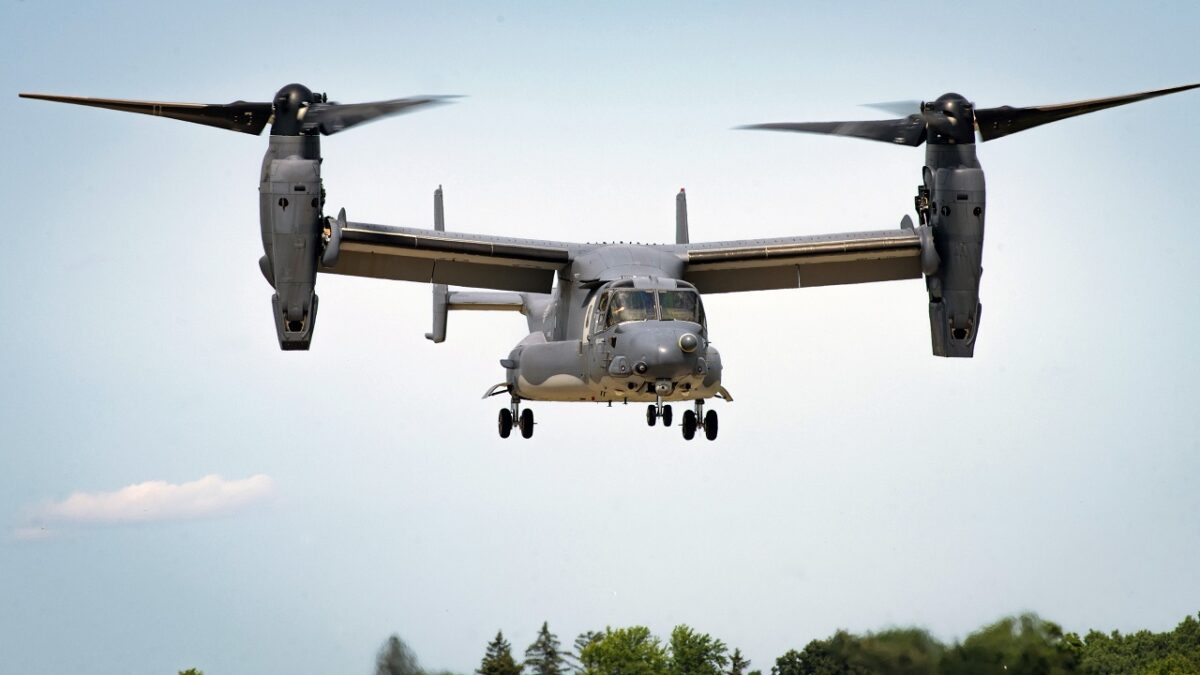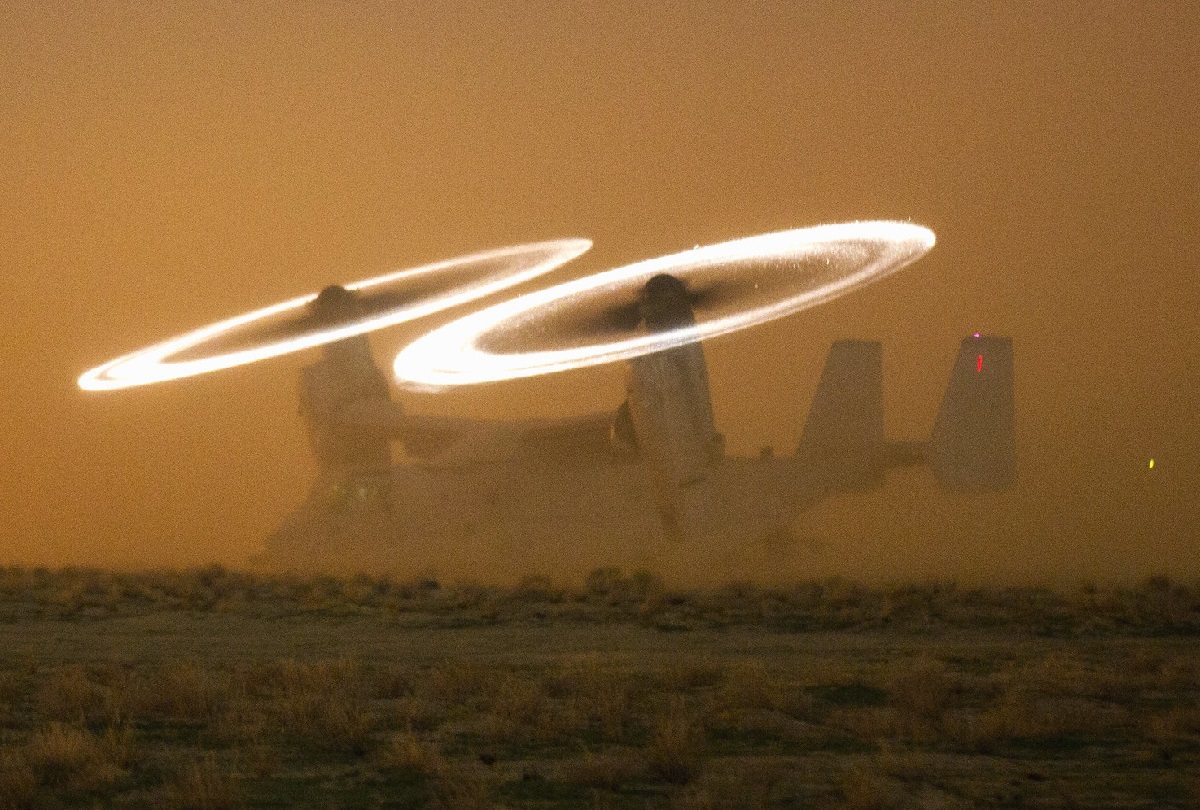Of all the unique, advanced airframes in the US military’s expansive inventory, the V-22 Osprey may be the most easily identifiable. Using tilt-rotors – rotors that can pivot between about 90 degrees mid-flight – the V-22 is basically an amalgamation of a prop plane and a helicopter. Uniquely versatile, the V-22 can perform both vertical and conventional takeoff/landings. The result is a single airframe that combines the utility of a helicopter with the velocity and range of a turboprop.
In most circumstances, the V-22 takes off and lands in “helicopter mode,” with its nacelles positioned vertically and its rotors moving horizontally. Then, once the V-22 is airborne, having achieved flight like a helicopter would, the nacelles are pushed forward 90 degrees until they are positioned like a traditional prop aircraft (the nacelle reconfiguration takes about 12 seconds).
The V-22’s origins lie in one of modern America’s most haunting political and military embarrassments: Operation Eagle Claw.
In 1980, President Jimmy Carter greenlit Operation Eagle Claw to extract the US hostages being held captive at the US Embassy in Iran. Famously, the operation was aborted – because of helicopter malfunction. It wasn’t just one helicopter that malfunctioned – like in the raid to assassinate Osama bin Laden; during Eagle Claw, three of eight helicopters malfunctioned – indicating decisively that the US was operating with deficient technologies.
While only four helicopters were needed to complete Operation Eagle Claw, mission procedures held that the mission would be aborted if less than six helicopters were available. The mission procedures accommodated the failure of twenty-five percent of the mission’s fleet. Still, the buffer wasn’t enough. Three helicopters failed – for one reason or another – and the mission was aborted.
The scope of the failure was expansive. Not only were US hostages left in Iran, consigned to wait until 1981 for release, but the botched operation contributed to Jimmy Carter’s political ruin. During the 1980 campaign, Carter was hounded for the failure of Operation Eagle Claw; GOP nominee Ronald Reagan cited Eagle Claw as a primary source of evidence to demonstrate Carter’s general weakness and inability to lead. The message stuck and Carter was routed in the election. Carter, now an old man, well into his 90s, acknowledges that failing to send additional helicopters on Eagle Claw was one of the biggest mistakes of his presidency.
War planners regretted Eagle Claw, too. But lessons were learned. In the 1980s, the Department of Defense founded the JVX aircraft program. Essentially, the JVX program was meant to result in an aircraft that could have pulled Eagle Claw off.
Bell and Boeing teamed up to fulfill the new JVX program. Bell, a helicopter manufacturer, worked on the wing, nacelles, rotors, drive system, tail surfaces, and aft ramp. Boeing, who has some helicopter making credentials but is mostly known for their fixed-wing aircraft, took care of the fuselage, cockpit, avionics, and flight controls.
As you might imagine, designing the V-22 – a novel piece of technology – was not always a smooth process. Decades were spent finagling over the details and the funding and the responsibilities. One Secretary of Defense, Dick Cheney, spent years trying to kill the program – only to have it revived when the Clinton administration took office. Yet despite the turmoil, the V-22 program persisted, through the 80s and through the 90s – behind schedule but moving forward. As flight testing began other problems, mechanical rather than political, began to emerge.

A CV-22 Osprey assigned to Air Force Special Operations Command prepares to land during an aerial demonstration at Wittman Regional Airport, Wis., July 30, 2021. With the various Air Force Special Operations Command aircraft and personnel in attendance, AFSOC brings specialized airpower and competitive advantage to the future warfighting environment. (U.S. Air Force photo by Senior Airman Miranda Mahoney)
The V-22 was dangerous to operate. And it was expensive to produce; after two decades of costly development, the V-22 finally went operational in the twenty-first century.
More concerningly, the tilt rotor craft kept crashing. In 2000, a total of 23 US Marines were killed when two V-22s went down in separate incidents.
Redesigns were incorporated but the reputation followed: The V-22 was an aircraft that pilots had to be especially careful in.

200718-N-GR168-1055 ATLANTIC OCEAN (July 18, 2020) An CMV-22B Osprey, attached to the Blackjacks of Air Test and Evaluation Squadron Two One (HX-21), lands on the flight deck aboard the amphibious transport dock ship USS New York (LPD 21), July 18, 2020. New York is operating in U.S. 2nd Fleet in support of naval operations to maintain maritime stability and security in order to ensure access, deter aggression and defend U.S., allied and partner interests. (U.S. Navy photo by Mass Communication Specialist 2nd Class Lyle Wilkie/Released)
The hassle and investment of designing the V-22 was probably not worth it; the Pentagon recently announced that V-22 production is coming to an end.
MORE: The F-35 Now Comes in Beast Mode
MORE: Why the U.S. Navy Tried to Sink Their Own Aircraft Carrier
Harrison Kass is the Senior Defense Editor at 19FortyFive. An attorney, pilot, guitarist, and minor pro hockey player, he joined the US Air Force as a Pilot Trainee but was medically discharged. Harrison holds a BA from Lake Forest College, a JD from the University of Oregon, and an MA from New York University. He lives in Oregon and listens to Dokken. Follow him on Twitter @harrison_kass.

